Impact of Culture, Power, and Politics on Organizational Behavior
VerifiedAdded on 2023/01/19
|15
|5125
|83
AI Summary
This report evaluates the impact of culture, power, and politics on organizational behavior. It discusses the different types of organizational culture, Hofstede's cultural dimensions, and the types of power within leadership. It also explores Maslow's theory of motivation and Vroom's expectancy theory. The importance of soft skills in managing teams is also highlighted. The case study focuses on Tesco, a British multinational retailer.
Contribute Materials
Your contribution can guide someone’s learning journey. Share your
documents today.
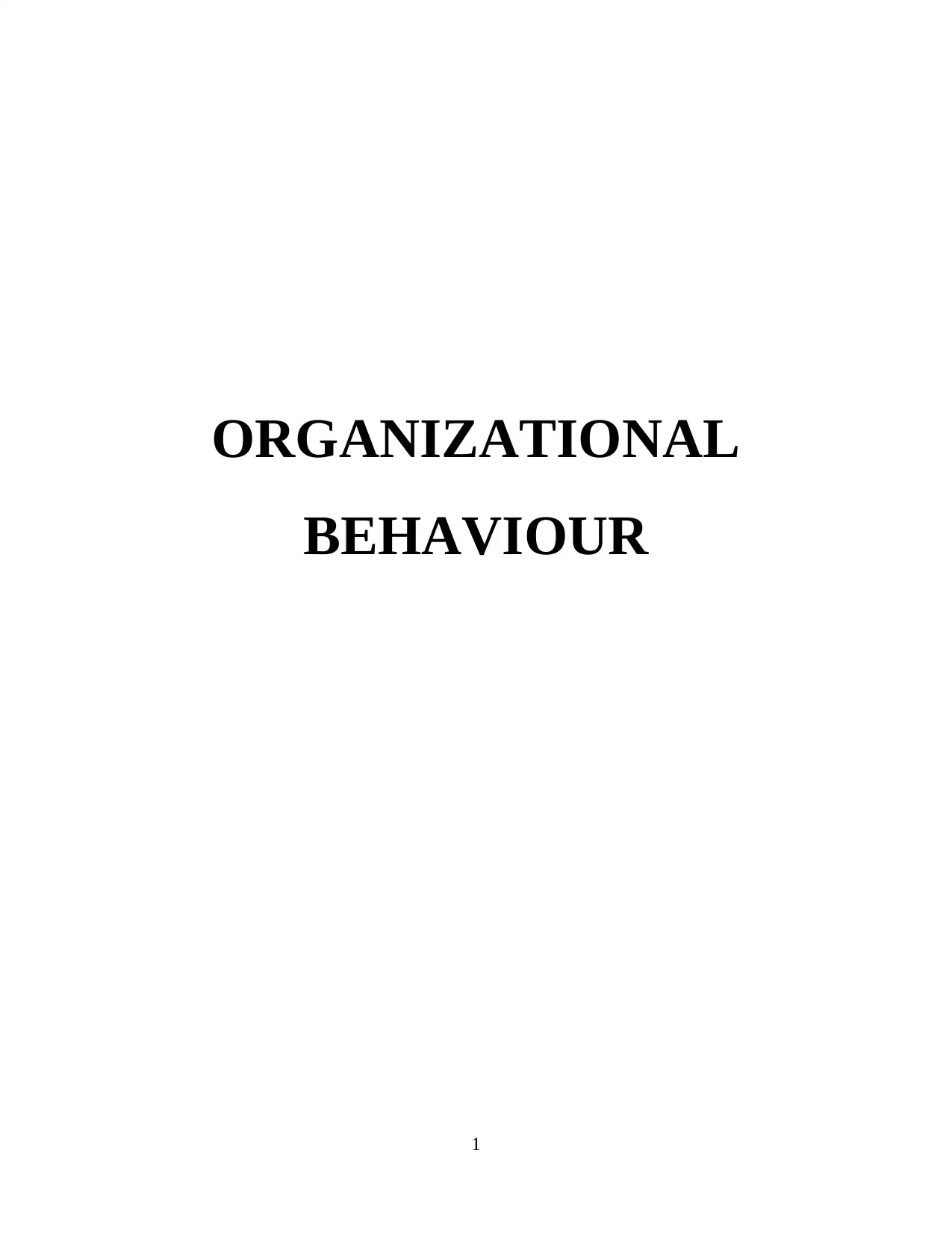
ORGANIZATIONAL
BEHAVIOUR
1
BEHAVIOUR
1
Secure Best Marks with AI Grader
Need help grading? Try our AI Grader for instant feedback on your assignments.
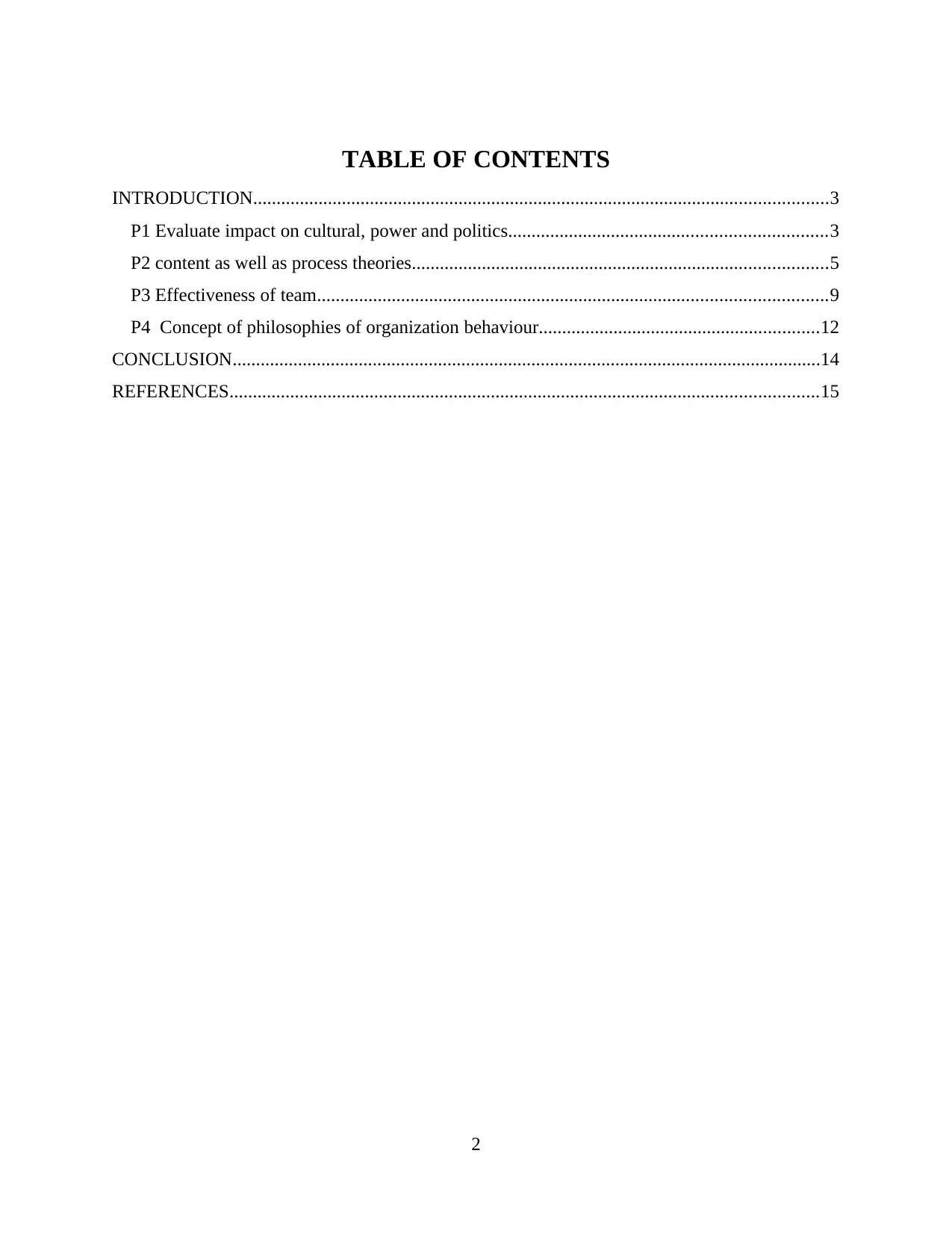
TABLE OF CONTENTS
INTRODUCTION...........................................................................................................................3
P1 Evaluate impact on cultural, power and politics....................................................................3
P2 content as well as process theories.........................................................................................5
P3 Effectiveness of team.............................................................................................................9
P4 Concept of philosophies of organization behaviour............................................................12
CONCLUSION..............................................................................................................................14
REFERENCES..............................................................................................................................15
2
INTRODUCTION...........................................................................................................................3
P1 Evaluate impact on cultural, power and politics....................................................................3
P2 content as well as process theories.........................................................................................5
P3 Effectiveness of team.............................................................................................................9
P4 Concept of philosophies of organization behaviour............................................................12
CONCLUSION..............................................................................................................................14
REFERENCES..............................................................................................................................15
2
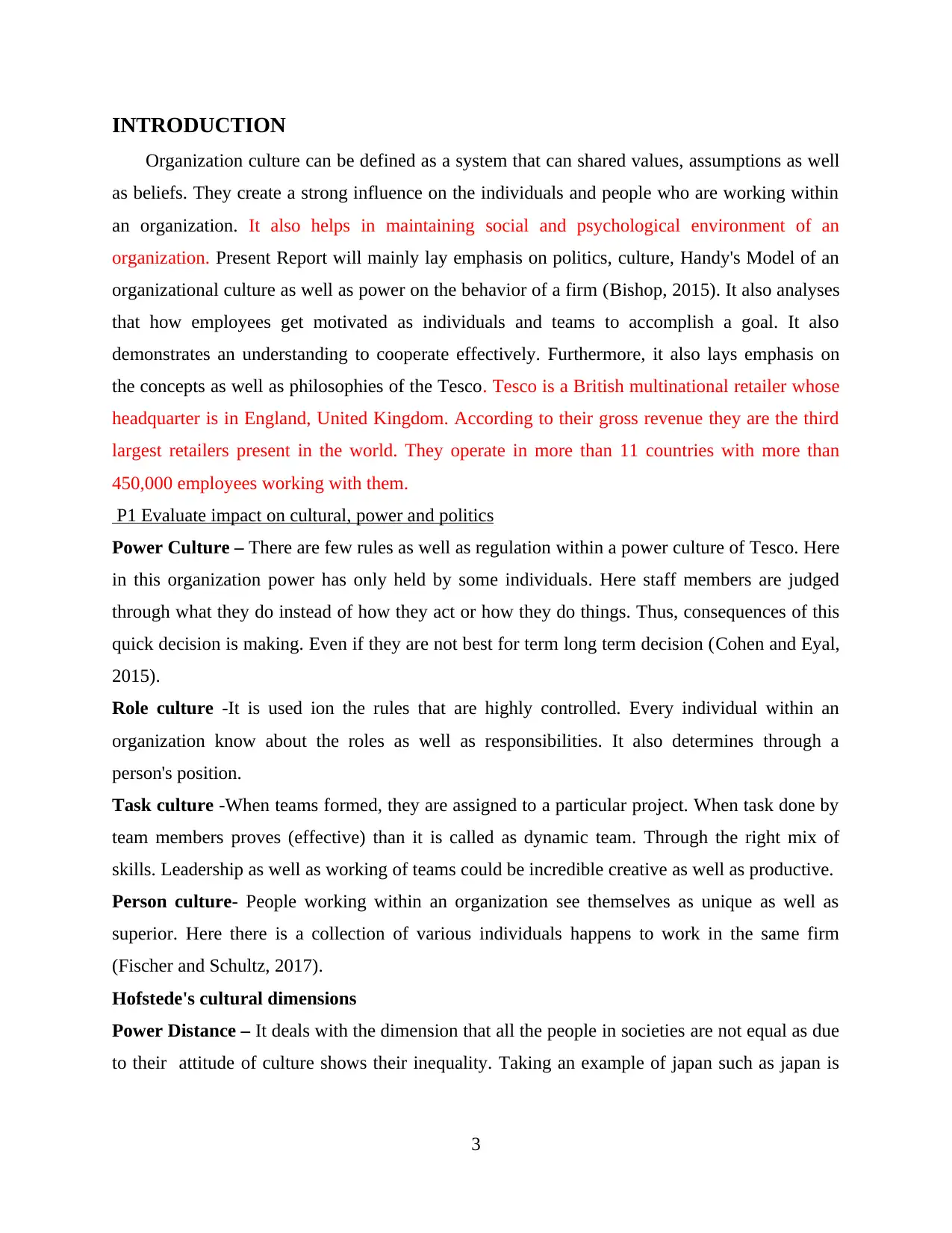
INTRODUCTION
Organization culture can be defined as a system that can shared values, assumptions as well
as beliefs. They create a strong influence on the individuals and people who are working within
an organization. It also helps in maintaining social and psychological environment of an
organization. Present Report will mainly lay emphasis on politics, culture, Handy's Model of an
organizational culture as well as power on the behavior of a firm (Bishop, 2015). It also analyses
that how employees get motivated as individuals and teams to accomplish a goal. It also
demonstrates an understanding to cooperate effectively. Furthermore, it also lays emphasis on
the concepts as well as philosophies of the Tesco. Tesco is a British multinational retailer whose
headquarter is in England, United Kingdom. According to their gross revenue they are the third
largest retailers present in the world. They operate in more than 11 countries with more than
450,000 employees working with them.
P1 Evaluate impact on cultural, power and politics
Power Culture – There are few rules as well as regulation within a power culture of Tesco. Here
in this organization power has only held by some individuals. Here staff members are judged
through what they do instead of how they act or how they do things. Thus, consequences of this
quick decision is making. Even if they are not best for term long term decision (Cohen and Eyal,
2015).
Role culture -It is used ion the rules that are highly controlled. Every individual within an
organization know about the roles as well as responsibilities. It also determines through a
person's position.
Task culture -When teams formed, they are assigned to a particular project. When task done by
team members proves (effective) than it is called as dynamic team. Through the right mix of
skills. Leadership as well as working of teams could be incredible creative as well as productive.
Person culture- People working within an organization see themselves as unique as well as
superior. Here there is a collection of various individuals happens to work in the same firm
(Fischer and Schultz, 2017).
Hofstede's cultural dimensions
Power Distance – It deals with the dimension that all the people in societies are not equal as due
to their attitude of culture shows their inequality. Taking an example of japan such as japan is
3
Organization culture can be defined as a system that can shared values, assumptions as well
as beliefs. They create a strong influence on the individuals and people who are working within
an organization. It also helps in maintaining social and psychological environment of an
organization. Present Report will mainly lay emphasis on politics, culture, Handy's Model of an
organizational culture as well as power on the behavior of a firm (Bishop, 2015). It also analyses
that how employees get motivated as individuals and teams to accomplish a goal. It also
demonstrates an understanding to cooperate effectively. Furthermore, it also lays emphasis on
the concepts as well as philosophies of the Tesco. Tesco is a British multinational retailer whose
headquarter is in England, United Kingdom. According to their gross revenue they are the third
largest retailers present in the world. They operate in more than 11 countries with more than
450,000 employees working with them.
P1 Evaluate impact on cultural, power and politics
Power Culture – There are few rules as well as regulation within a power culture of Tesco. Here
in this organization power has only held by some individuals. Here staff members are judged
through what they do instead of how they act or how they do things. Thus, consequences of this
quick decision is making. Even if they are not best for term long term decision (Cohen and Eyal,
2015).
Role culture -It is used ion the rules that are highly controlled. Every individual within an
organization know about the roles as well as responsibilities. It also determines through a
person's position.
Task culture -When teams formed, they are assigned to a particular project. When task done by
team members proves (effective) than it is called as dynamic team. Through the right mix of
skills. Leadership as well as working of teams could be incredible creative as well as productive.
Person culture- People working within an organization see themselves as unique as well as
superior. Here there is a collection of various individuals happens to work in the same firm
(Fischer and Schultz, 2017).
Hofstede's cultural dimensions
Power Distance – It deals with the dimension that all the people in societies are not equal as due
to their attitude of culture shows their inequality. Taking an example of japan such as japan is
3
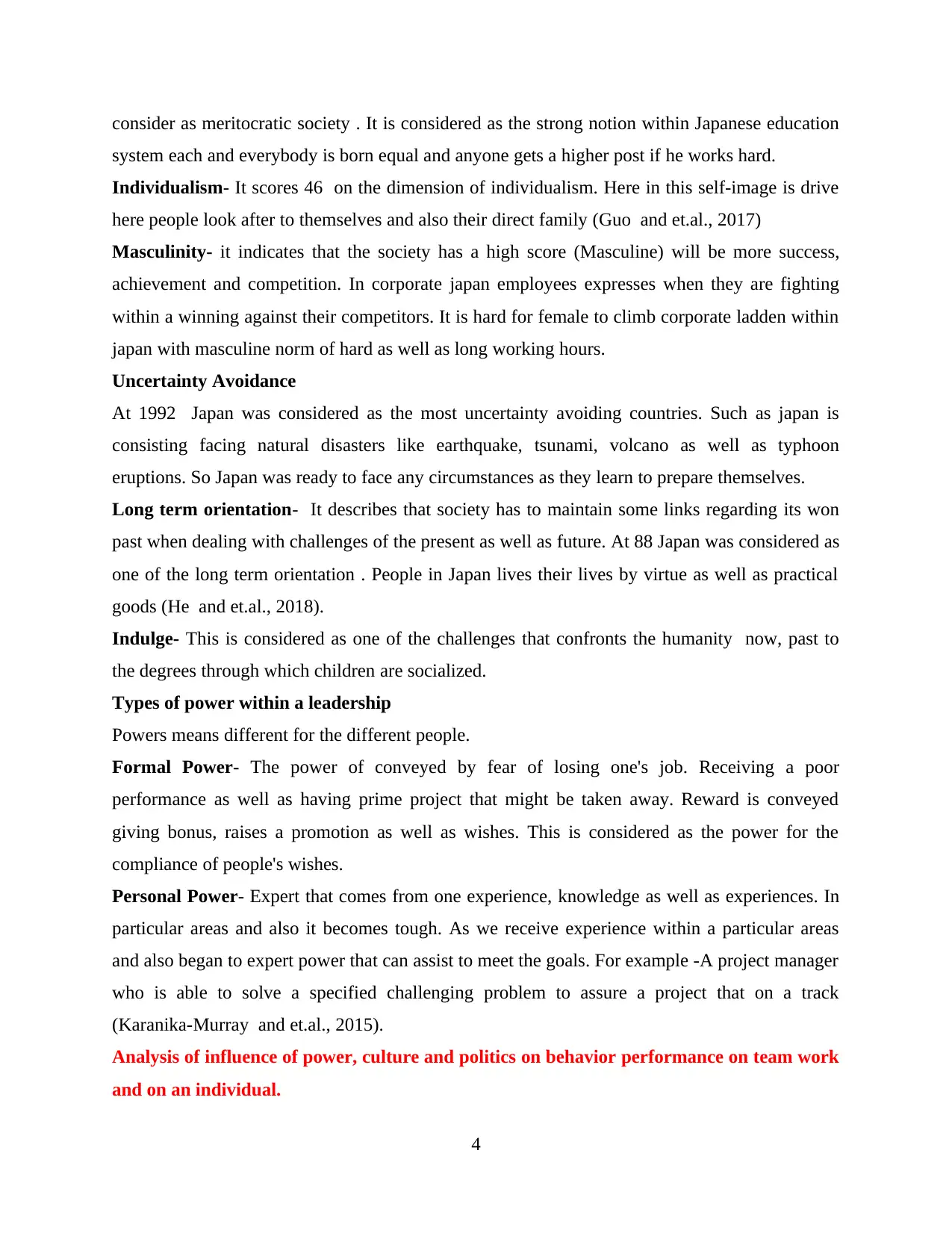
consider as meritocratic society . It is considered as the strong notion within Japanese education
system each and everybody is born equal and anyone gets a higher post if he works hard.
Individualism- It scores 46 on the dimension of individualism. Here in this self-image is drive
here people look after to themselves and also their direct family (Guo and et.al., 2017)
Masculinity- it indicates that the society has a high score (Masculine) will be more success,
achievement and competition. In corporate japan employees expresses when they are fighting
within a winning against their competitors. It is hard for female to climb corporate ladden within
japan with masculine norm of hard as well as long working hours.
Uncertainty Avoidance
At 1992 Japan was considered as the most uncertainty avoiding countries. Such as japan is
consisting facing natural disasters like earthquake, tsunami, volcano as well as typhoon
eruptions. So Japan was ready to face any circumstances as they learn to prepare themselves.
Long term orientation- It describes that society has to maintain some links regarding its won
past when dealing with challenges of the present as well as future. At 88 Japan was considered as
one of the long term orientation . People in Japan lives their lives by virtue as well as practical
goods (He and et.al., 2018).
Indulge- This is considered as one of the challenges that confronts the humanity now, past to
the degrees through which children are socialized.
Types of power within a leadership
Powers means different for the different people.
Formal Power- The power of conveyed by fear of losing one's job. Receiving a poor
performance as well as having prime project that might be taken away. Reward is conveyed
giving bonus, raises a promotion as well as wishes. This is considered as the power for the
compliance of people's wishes.
Personal Power- Expert that comes from one experience, knowledge as well as experiences. In
particular areas and also it becomes tough. As we receive experience within a particular areas
and also began to expert power that can assist to meet the goals. For example -A project manager
who is able to solve a specified challenging problem to assure a project that on a track
(Karanika-Murray and et.al., 2015).
Analysis of influence of power, culture and politics on behavior performance on team work
and on an individual.
4
system each and everybody is born equal and anyone gets a higher post if he works hard.
Individualism- It scores 46 on the dimension of individualism. Here in this self-image is drive
here people look after to themselves and also their direct family (Guo and et.al., 2017)
Masculinity- it indicates that the society has a high score (Masculine) will be more success,
achievement and competition. In corporate japan employees expresses when they are fighting
within a winning against their competitors. It is hard for female to climb corporate ladden within
japan with masculine norm of hard as well as long working hours.
Uncertainty Avoidance
At 1992 Japan was considered as the most uncertainty avoiding countries. Such as japan is
consisting facing natural disasters like earthquake, tsunami, volcano as well as typhoon
eruptions. So Japan was ready to face any circumstances as they learn to prepare themselves.
Long term orientation- It describes that society has to maintain some links regarding its won
past when dealing with challenges of the present as well as future. At 88 Japan was considered as
one of the long term orientation . People in Japan lives their lives by virtue as well as practical
goods (He and et.al., 2018).
Indulge- This is considered as one of the challenges that confronts the humanity now, past to
the degrees through which children are socialized.
Types of power within a leadership
Powers means different for the different people.
Formal Power- The power of conveyed by fear of losing one's job. Receiving a poor
performance as well as having prime project that might be taken away. Reward is conveyed
giving bonus, raises a promotion as well as wishes. This is considered as the power for the
compliance of people's wishes.
Personal Power- Expert that comes from one experience, knowledge as well as experiences. In
particular areas and also it becomes tough. As we receive experience within a particular areas
and also began to expert power that can assist to meet the goals. For example -A project manager
who is able to solve a specified challenging problem to assure a project that on a track
(Karanika-Murray and et.al., 2015).
Analysis of influence of power, culture and politics on behavior performance on team work
and on an individual.
4
Secure Best Marks with AI Grader
Need help grading? Try our AI Grader for instant feedback on your assignments.
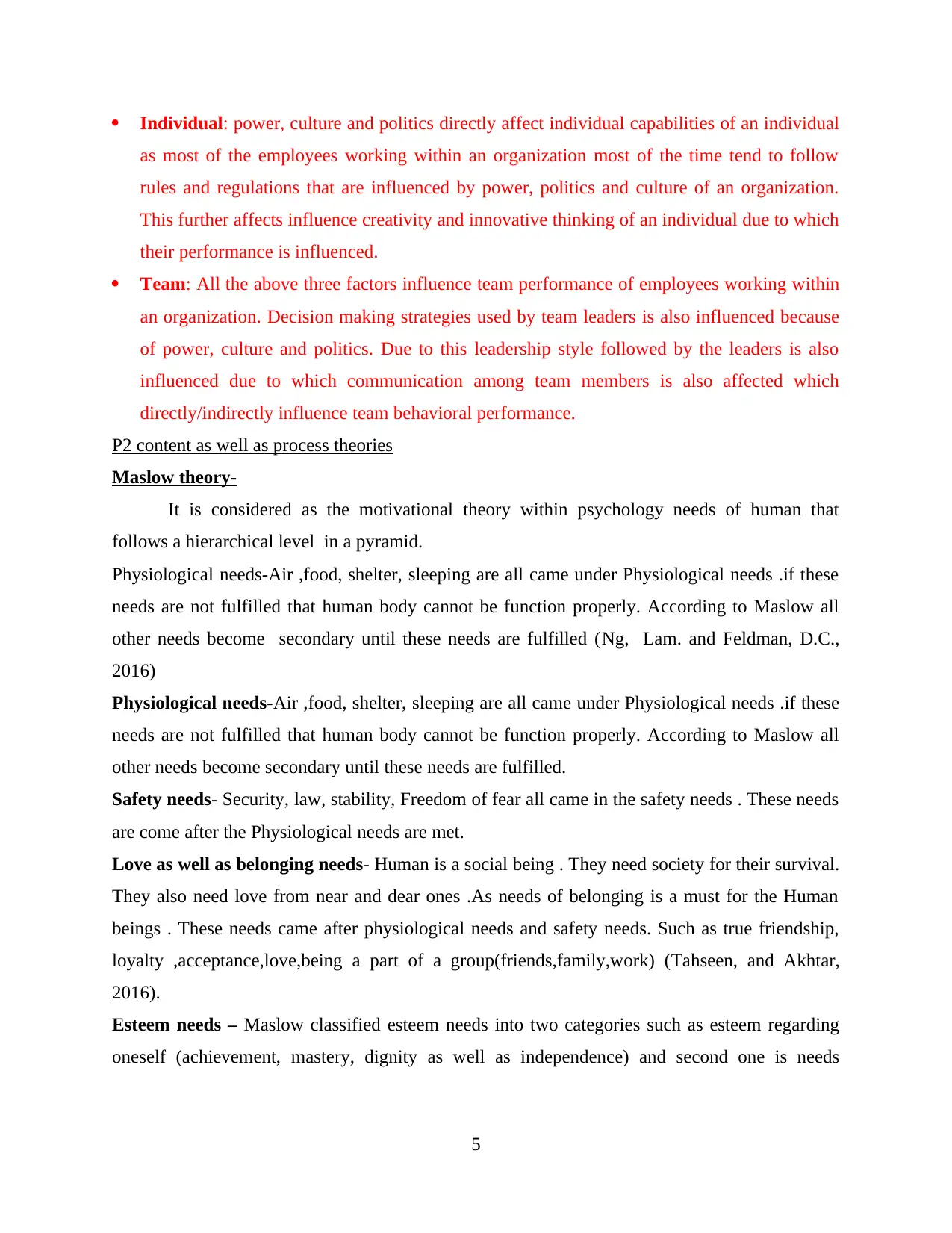
Individual: power, culture and politics directly affect individual capabilities of an individual
as most of the employees working within an organization most of the time tend to follow
rules and regulations that are influenced by power, politics and culture of an organization.
This further affects influence creativity and innovative thinking of an individual due to which
their performance is influenced.
Team: All the above three factors influence team performance of employees working within
an organization. Decision making strategies used by team leaders is also influenced because
of power, culture and politics. Due to this leadership style followed by the leaders is also
influenced due to which communication among team members is also affected which
directly/indirectly influence team behavioral performance.
P2 content as well as process theories
Maslow theory-
It is considered as the motivational theory within psychology needs of human that
follows a hierarchical level in a pyramid.
Physiological needs-Air ,food, shelter, sleeping are all came under Physiological needs .if these
needs are not fulfilled that human body cannot be function properly. According to Maslow all
other needs become secondary until these needs are fulfilled (Ng, Lam. and Feldman, D.C.,
2016)
Physiological needs-Air ,food, shelter, sleeping are all came under Physiological needs .if these
needs are not fulfilled that human body cannot be function properly. According to Maslow all
other needs become secondary until these needs are fulfilled.
Safety needs- Security, law, stability, Freedom of fear all came in the safety needs . These needs
are come after the Physiological needs are met.
Love as well as belonging needs- Human is a social being . They need society for their survival.
They also need love from near and dear ones .As needs of belonging is a must for the Human
beings . These needs came after physiological needs and safety needs. Such as true friendship,
loyalty ,acceptance,love,being a part of a group(friends,family,work) (Tahseen, and Akhtar,
2016).
Esteem needs – Maslow classified esteem needs into two categories such as esteem regarding
oneself (achievement, mastery, dignity as well as independence) and second one is needs
5
as most of the employees working within an organization most of the time tend to follow
rules and regulations that are influenced by power, politics and culture of an organization.
This further affects influence creativity and innovative thinking of an individual due to which
their performance is influenced.
Team: All the above three factors influence team performance of employees working within
an organization. Decision making strategies used by team leaders is also influenced because
of power, culture and politics. Due to this leadership style followed by the leaders is also
influenced due to which communication among team members is also affected which
directly/indirectly influence team behavioral performance.
P2 content as well as process theories
Maslow theory-
It is considered as the motivational theory within psychology needs of human that
follows a hierarchical level in a pyramid.
Physiological needs-Air ,food, shelter, sleeping are all came under Physiological needs .if these
needs are not fulfilled that human body cannot be function properly. According to Maslow all
other needs become secondary until these needs are fulfilled (Ng, Lam. and Feldman, D.C.,
2016)
Physiological needs-Air ,food, shelter, sleeping are all came under Physiological needs .if these
needs are not fulfilled that human body cannot be function properly. According to Maslow all
other needs become secondary until these needs are fulfilled.
Safety needs- Security, law, stability, Freedom of fear all came in the safety needs . These needs
are come after the Physiological needs are met.
Love as well as belonging needs- Human is a social being . They need society for their survival.
They also need love from near and dear ones .As needs of belonging is a must for the Human
beings . These needs came after physiological needs and safety needs. Such as true friendship,
loyalty ,acceptance,love,being a part of a group(friends,family,work) (Tahseen, and Akhtar,
2016).
Esteem needs – Maslow classified esteem needs into two categories such as esteem regarding
oneself (achievement, mastery, dignity as well as independence) and second one is needs
5
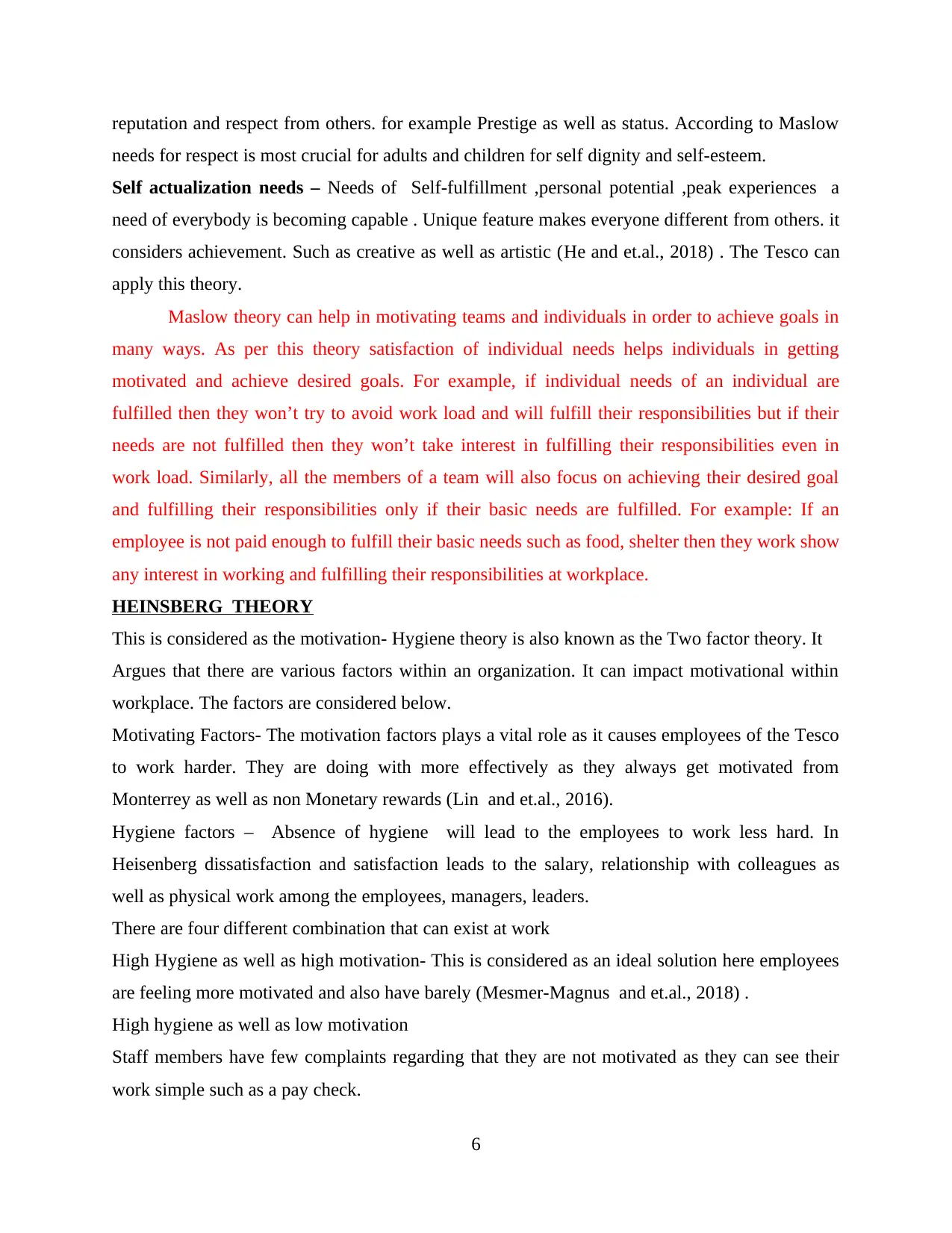
reputation and respect from others. for example Prestige as well as status. According to Maslow
needs for respect is most crucial for adults and children for self dignity and self-esteem.
Self actualization needs – Needs of Self-fulfillment ,personal potential ,peak experiences a
need of everybody is becoming capable . Unique feature makes everyone different from others. it
considers achievement. Such as creative as well as artistic (He and et.al., 2018) . The Tesco can
apply this theory.
Maslow theory can help in motivating teams and individuals in order to achieve goals in
many ways. As per this theory satisfaction of individual needs helps individuals in getting
motivated and achieve desired goals. For example, if individual needs of an individual are
fulfilled then they won’t try to avoid work load and will fulfill their responsibilities but if their
needs are not fulfilled then they won’t take interest in fulfilling their responsibilities even in
work load. Similarly, all the members of a team will also focus on achieving their desired goal
and fulfilling their responsibilities only if their basic needs are fulfilled. For example: If an
employee is not paid enough to fulfill their basic needs such as food, shelter then they work show
any interest in working and fulfilling their responsibilities at workplace.
HEINSBERG THEORY
This is considered as the motivation- Hygiene theory is also known as the Two factor theory. It
Argues that there are various factors within an organization. It can impact motivational within
workplace. The factors are considered below.
Motivating Factors- The motivation factors plays a vital role as it causes employees of the Tesco
to work harder. They are doing with more effectively as they always get motivated from
Monterrey as well as non Monetary rewards (Lin and et.al., 2016).
Hygiene factors – Absence of hygiene will lead to the employees to work less hard. In
Heisenberg dissatisfaction and satisfaction leads to the salary, relationship with colleagues as
well as physical work among the employees, managers, leaders.
There are four different combination that can exist at work
High Hygiene as well as high motivation- This is considered as an ideal solution here employees
are feeling more motivated and also have barely (Mesmer-Magnus and et.al., 2018) .
High hygiene as well as low motivation
Staff members have few complaints regarding that they are not motivated as they can see their
work simple such as a pay check.
6
needs for respect is most crucial for adults and children for self dignity and self-esteem.
Self actualization needs – Needs of Self-fulfillment ,personal potential ,peak experiences a
need of everybody is becoming capable . Unique feature makes everyone different from others. it
considers achievement. Such as creative as well as artistic (He and et.al., 2018) . The Tesco can
apply this theory.
Maslow theory can help in motivating teams and individuals in order to achieve goals in
many ways. As per this theory satisfaction of individual needs helps individuals in getting
motivated and achieve desired goals. For example, if individual needs of an individual are
fulfilled then they won’t try to avoid work load and will fulfill their responsibilities but if their
needs are not fulfilled then they won’t take interest in fulfilling their responsibilities even in
work load. Similarly, all the members of a team will also focus on achieving their desired goal
and fulfilling their responsibilities only if their basic needs are fulfilled. For example: If an
employee is not paid enough to fulfill their basic needs such as food, shelter then they work show
any interest in working and fulfilling their responsibilities at workplace.
HEINSBERG THEORY
This is considered as the motivation- Hygiene theory is also known as the Two factor theory. It
Argues that there are various factors within an organization. It can impact motivational within
workplace. The factors are considered below.
Motivating Factors- The motivation factors plays a vital role as it causes employees of the Tesco
to work harder. They are doing with more effectively as they always get motivated from
Monterrey as well as non Monetary rewards (Lin and et.al., 2016).
Hygiene factors – Absence of hygiene will lead to the employees to work less hard. In
Heisenberg dissatisfaction and satisfaction leads to the salary, relationship with colleagues as
well as physical work among the employees, managers, leaders.
There are four different combination that can exist at work
High Hygiene as well as high motivation- This is considered as an ideal solution here employees
are feeling more motivated and also have barely (Mesmer-Magnus and et.al., 2018) .
High hygiene as well as low motivation
Staff members have few complaints regarding that they are not motivated as they can see their
work simple such as a pay check.
6
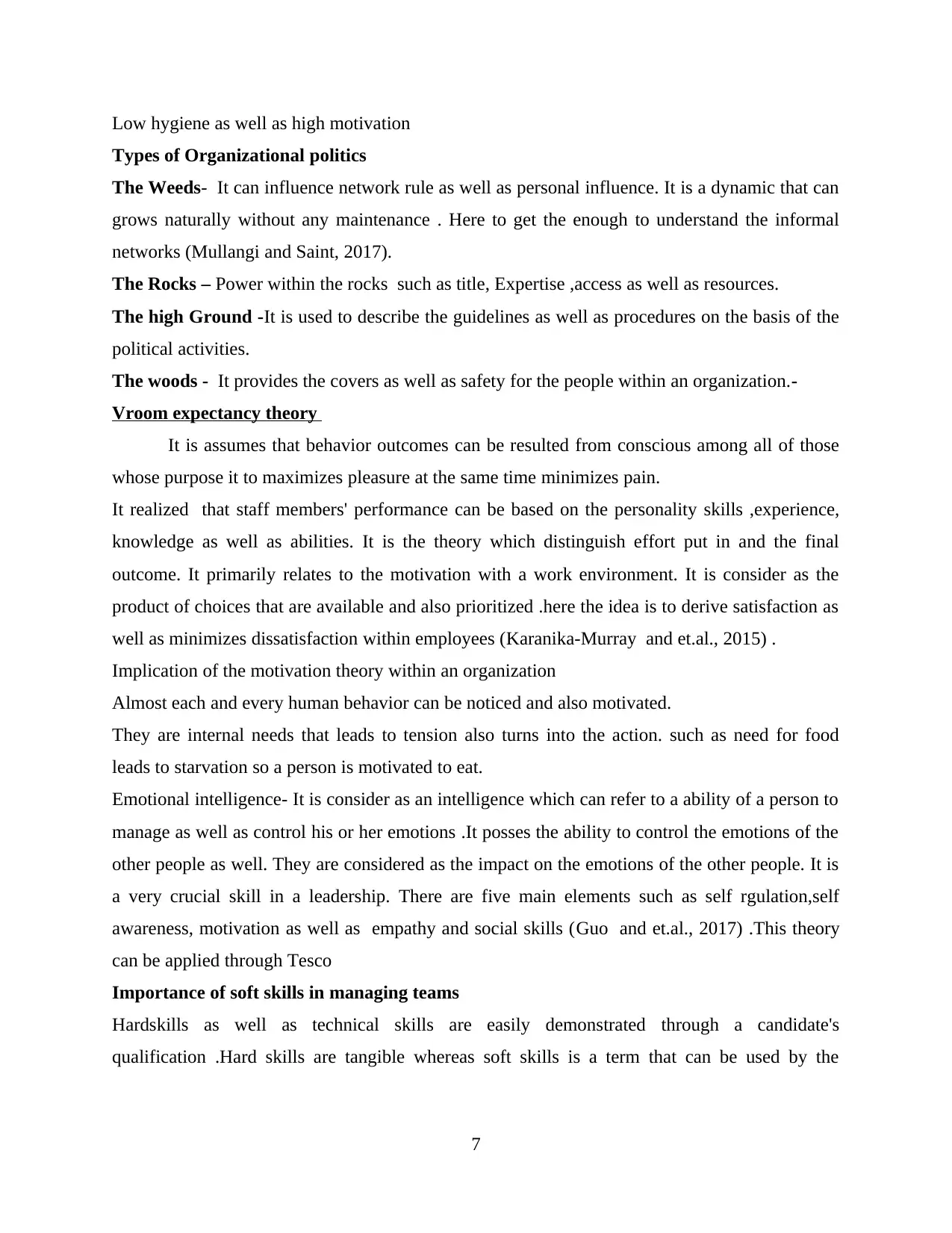
Low hygiene as well as high motivation
Types of Organizational politics
The Weeds- It can influence network rule as well as personal influence. It is a dynamic that can
grows naturally without any maintenance . Here to get the enough to understand the informal
networks (Mullangi and Saint, 2017).
The Rocks – Power within the rocks such as title, Expertise ,access as well as resources.
The high Ground -It is used to describe the guidelines as well as procedures on the basis of the
political activities.
The woods - It provides the covers as well as safety for the people within an organization.-
Vroom expectancy theory
It is assumes that behavior outcomes can be resulted from conscious among all of those
whose purpose it to maximizes pleasure at the same time minimizes pain.
It realized that staff members' performance can be based on the personality skills ,experience,
knowledge as well as abilities. It is the theory which distinguish effort put in and the final
outcome. It primarily relates to the motivation with a work environment. It is consider as the
product of choices that are available and also prioritized .here the idea is to derive satisfaction as
well as minimizes dissatisfaction within employees (Karanika-Murray and et.al., 2015) .
Implication of the motivation theory within an organization
Almost each and every human behavior can be noticed and also motivated.
They are internal needs that leads to tension also turns into the action. such as need for food
leads to starvation so a person is motivated to eat.
Emotional intelligence- It is consider as an intelligence which can refer to a ability of a person to
manage as well as control his or her emotions .It posses the ability to control the emotions of the
other people as well. They are considered as the impact on the emotions of the other people. It is
a very crucial skill in a leadership. There are five main elements such as self rgulation,self
awareness, motivation as well as empathy and social skills (Guo and et.al., 2017) .This theory
can be applied through Tesco
Importance of soft skills in managing teams
Hardskills as well as technical skills are easily demonstrated through a candidate's
qualification .Hard skills are tangible whereas soft skills is a term that can be used by the
7
Types of Organizational politics
The Weeds- It can influence network rule as well as personal influence. It is a dynamic that can
grows naturally without any maintenance . Here to get the enough to understand the informal
networks (Mullangi and Saint, 2017).
The Rocks – Power within the rocks such as title, Expertise ,access as well as resources.
The high Ground -It is used to describe the guidelines as well as procedures on the basis of the
political activities.
The woods - It provides the covers as well as safety for the people within an organization.-
Vroom expectancy theory
It is assumes that behavior outcomes can be resulted from conscious among all of those
whose purpose it to maximizes pleasure at the same time minimizes pain.
It realized that staff members' performance can be based on the personality skills ,experience,
knowledge as well as abilities. It is the theory which distinguish effort put in and the final
outcome. It primarily relates to the motivation with a work environment. It is consider as the
product of choices that are available and also prioritized .here the idea is to derive satisfaction as
well as minimizes dissatisfaction within employees (Karanika-Murray and et.al., 2015) .
Implication of the motivation theory within an organization
Almost each and every human behavior can be noticed and also motivated.
They are internal needs that leads to tension also turns into the action. such as need for food
leads to starvation so a person is motivated to eat.
Emotional intelligence- It is consider as an intelligence which can refer to a ability of a person to
manage as well as control his or her emotions .It posses the ability to control the emotions of the
other people as well. They are considered as the impact on the emotions of the other people. It is
a very crucial skill in a leadership. There are five main elements such as self rgulation,self
awareness, motivation as well as empathy and social skills (Guo and et.al., 2017) .This theory
can be applied through Tesco
Importance of soft skills in managing teams
Hardskills as well as technical skills are easily demonstrated through a candidate's
qualification .Hard skills are tangible whereas soft skills is a term that can be used by the
7
Paraphrase This Document
Need a fresh take? Get an instant paraphrase of this document with our AI Paraphraser
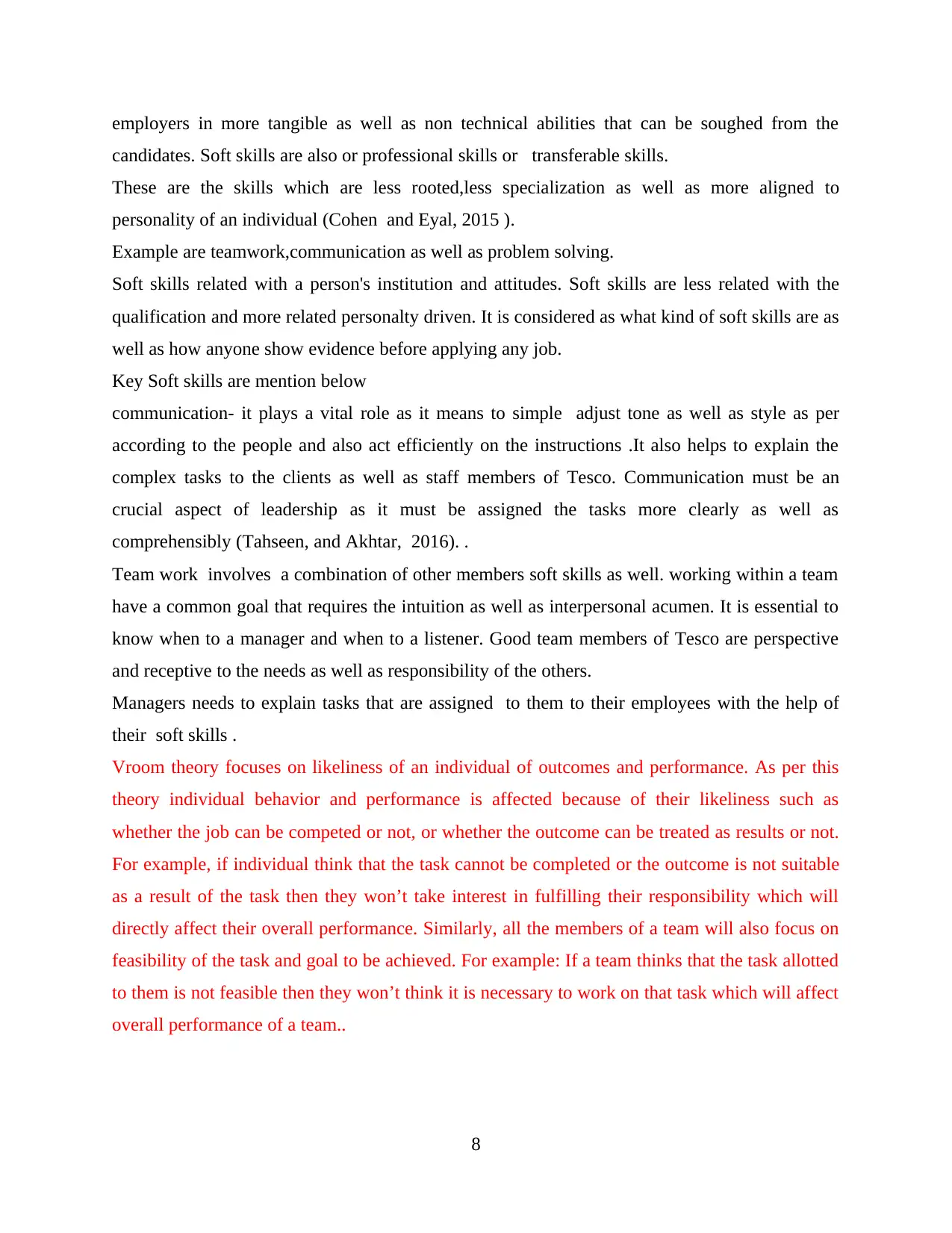
employers in more tangible as well as non technical abilities that can be soughed from the
candidates. Soft skills are also or professional skills or transferable skills.
These are the skills which are less rooted,less specialization as well as more aligned to
personality of an individual (Cohen and Eyal, 2015 ).
Example are teamwork,communication as well as problem solving.
Soft skills related with a person's institution and attitudes. Soft skills are less related with the
qualification and more related personalty driven. It is considered as what kind of soft skills are as
well as how anyone show evidence before applying any job.
Key Soft skills are mention below
communication- it plays a vital role as it means to simple adjust tone as well as style as per
according to the people and also act efficiently on the instructions .It also helps to explain the
complex tasks to the clients as well as staff members of Tesco. Communication must be an
crucial aspect of leadership as it must be assigned the tasks more clearly as well as
comprehensibly (Tahseen, and Akhtar, 2016). .
Team work involves a combination of other members soft skills as well. working within a team
have a common goal that requires the intuition as well as interpersonal acumen. It is essential to
know when to a manager and when to a listener. Good team members of Tesco are perspective
and receptive to the needs as well as responsibility of the others.
Managers needs to explain tasks that are assigned to them to their employees with the help of
their soft skills .
Vroom theory focuses on likeliness of an individual of outcomes and performance. As per this
theory individual behavior and performance is affected because of their likeliness such as
whether the job can be competed or not, or whether the outcome can be treated as results or not.
For example, if individual think that the task cannot be completed or the outcome is not suitable
as a result of the task then they won’t take interest in fulfilling their responsibility which will
directly affect their overall performance. Similarly, all the members of a team will also focus on
feasibility of the task and goal to be achieved. For example: If a team thinks that the task allotted
to them is not feasible then they won’t think it is necessary to work on that task which will affect
overall performance of a team..
8
candidates. Soft skills are also or professional skills or transferable skills.
These are the skills which are less rooted,less specialization as well as more aligned to
personality of an individual (Cohen and Eyal, 2015 ).
Example are teamwork,communication as well as problem solving.
Soft skills related with a person's institution and attitudes. Soft skills are less related with the
qualification and more related personalty driven. It is considered as what kind of soft skills are as
well as how anyone show evidence before applying any job.
Key Soft skills are mention below
communication- it plays a vital role as it means to simple adjust tone as well as style as per
according to the people and also act efficiently on the instructions .It also helps to explain the
complex tasks to the clients as well as staff members of Tesco. Communication must be an
crucial aspect of leadership as it must be assigned the tasks more clearly as well as
comprehensibly (Tahseen, and Akhtar, 2016). .
Team work involves a combination of other members soft skills as well. working within a team
have a common goal that requires the intuition as well as interpersonal acumen. It is essential to
know when to a manager and when to a listener. Good team members of Tesco are perspective
and receptive to the needs as well as responsibility of the others.
Managers needs to explain tasks that are assigned to them to their employees with the help of
their soft skills .
Vroom theory focuses on likeliness of an individual of outcomes and performance. As per this
theory individual behavior and performance is affected because of their likeliness such as
whether the job can be competed or not, or whether the outcome can be treated as results or not.
For example, if individual think that the task cannot be completed or the outcome is not suitable
as a result of the task then they won’t take interest in fulfilling their responsibility which will
directly affect their overall performance. Similarly, all the members of a team will also focus on
feasibility of the task and goal to be achieved. For example: If a team thinks that the task allotted
to them is not feasible then they won’t think it is necessary to work on that task which will affect
overall performance of a team..
8
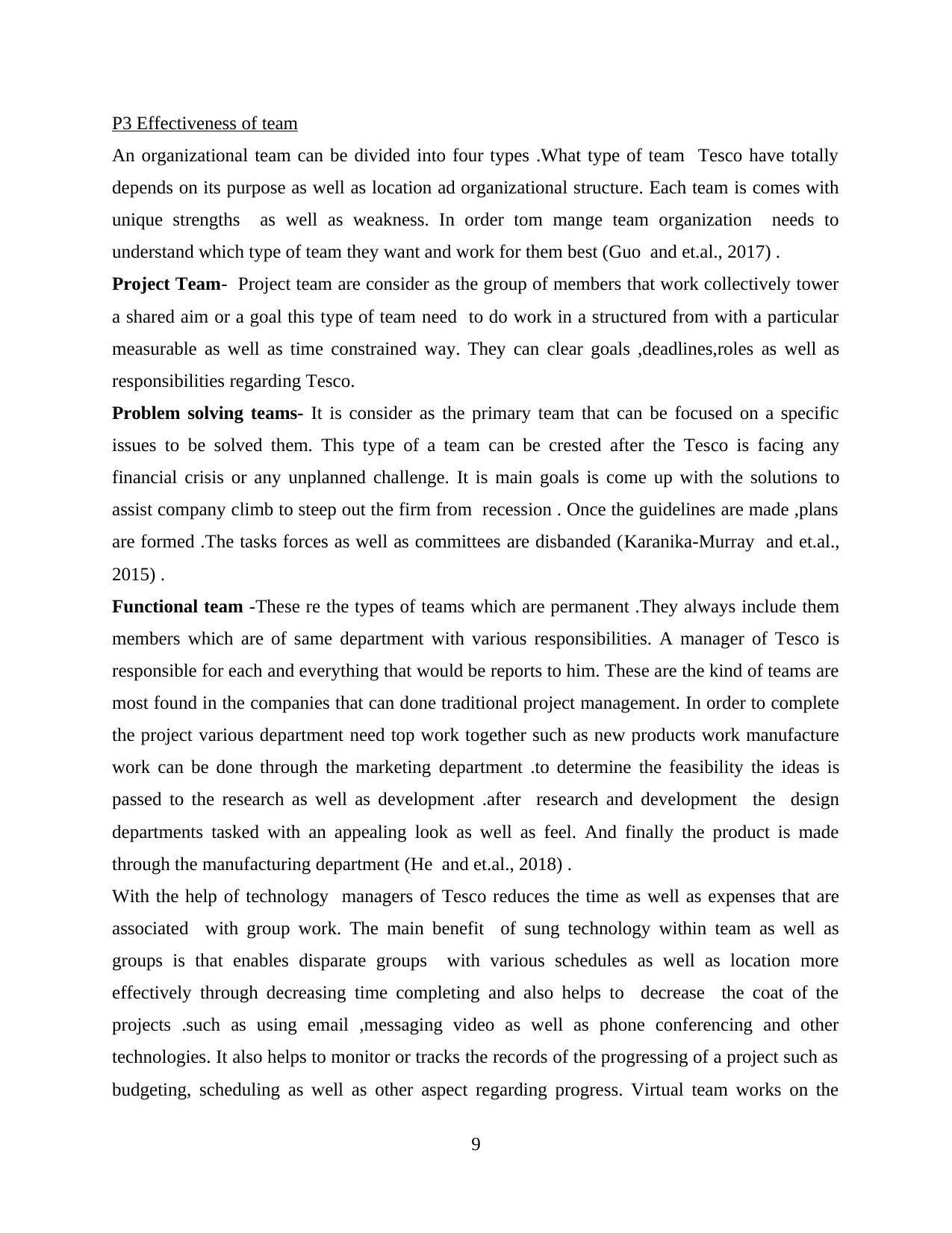
P3 Effectiveness of team
An organizational team can be divided into four types .What type of team Tesco have totally
depends on its purpose as well as location ad organizational structure. Each team is comes with
unique strengths as well as weakness. In order tom mange team organization needs to
understand which type of team they want and work for them best (Guo and et.al., 2017) .
Project Team- Project team are consider as the group of members that work collectively tower
a shared aim or a goal this type of team need to do work in a structured from with a particular
measurable as well as time constrained way. They can clear goals ,deadlines,roles as well as
responsibilities regarding Tesco.
Problem solving teams- It is consider as the primary team that can be focused on a specific
issues to be solved them. This type of a team can be crested after the Tesco is facing any
financial crisis or any unplanned challenge. It is main goals is come up with the solutions to
assist company climb to steep out the firm from recession . Once the guidelines are made ,plans
are formed .The tasks forces as well as committees are disbanded (Karanika-Murray and et.al.,
2015) .
Functional team -These re the types of teams which are permanent .They always include them
members which are of same department with various responsibilities. A manager of Tesco is
responsible for each and everything that would be reports to him. These are the kind of teams are
most found in the companies that can done traditional project management. In order to complete
the project various department need top work together such as new products work manufacture
work can be done through the marketing department .to determine the feasibility the ideas is
passed to the research as well as development .after research and development the design
departments tasked with an appealing look as well as feel. And finally the product is made
through the manufacturing department (He and et.al., 2018) .
With the help of technology managers of Tesco reduces the time as well as expenses that are
associated with group work. The main benefit of sung technology within team as well as
groups is that enables disparate groups with various schedules as well as location more
effectively through decreasing time completing and also helps to decrease the coat of the
projects .such as using email ,messaging video as well as phone conferencing and other
technologies. It also helps to monitor or tracks the records of the progressing of a project such as
budgeting, scheduling as well as other aspect regarding progress. Virtual team works on the
9
An organizational team can be divided into four types .What type of team Tesco have totally
depends on its purpose as well as location ad organizational structure. Each team is comes with
unique strengths as well as weakness. In order tom mange team organization needs to
understand which type of team they want and work for them best (Guo and et.al., 2017) .
Project Team- Project team are consider as the group of members that work collectively tower
a shared aim or a goal this type of team need to do work in a structured from with a particular
measurable as well as time constrained way. They can clear goals ,deadlines,roles as well as
responsibilities regarding Tesco.
Problem solving teams- It is consider as the primary team that can be focused on a specific
issues to be solved them. This type of a team can be crested after the Tesco is facing any
financial crisis or any unplanned challenge. It is main goals is come up with the solutions to
assist company climb to steep out the firm from recession . Once the guidelines are made ,plans
are formed .The tasks forces as well as committees are disbanded (Karanika-Murray and et.al.,
2015) .
Functional team -These re the types of teams which are permanent .They always include them
members which are of same department with various responsibilities. A manager of Tesco is
responsible for each and everything that would be reports to him. These are the kind of teams are
most found in the companies that can done traditional project management. In order to complete
the project various department need top work together such as new products work manufacture
work can be done through the marketing department .to determine the feasibility the ideas is
passed to the research as well as development .after research and development the design
departments tasked with an appealing look as well as feel. And finally the product is made
through the manufacturing department (He and et.al., 2018) .
With the help of technology managers of Tesco reduces the time as well as expenses that are
associated with group work. The main benefit of sung technology within team as well as
groups is that enables disparate groups with various schedules as well as location more
effectively through decreasing time completing and also helps to decrease the coat of the
projects .such as using email ,messaging video as well as phone conferencing and other
technologies. It also helps to monitor or tracks the records of the progressing of a project such as
budgeting, scheduling as well as other aspect regarding progress. Virtual team works on the
9
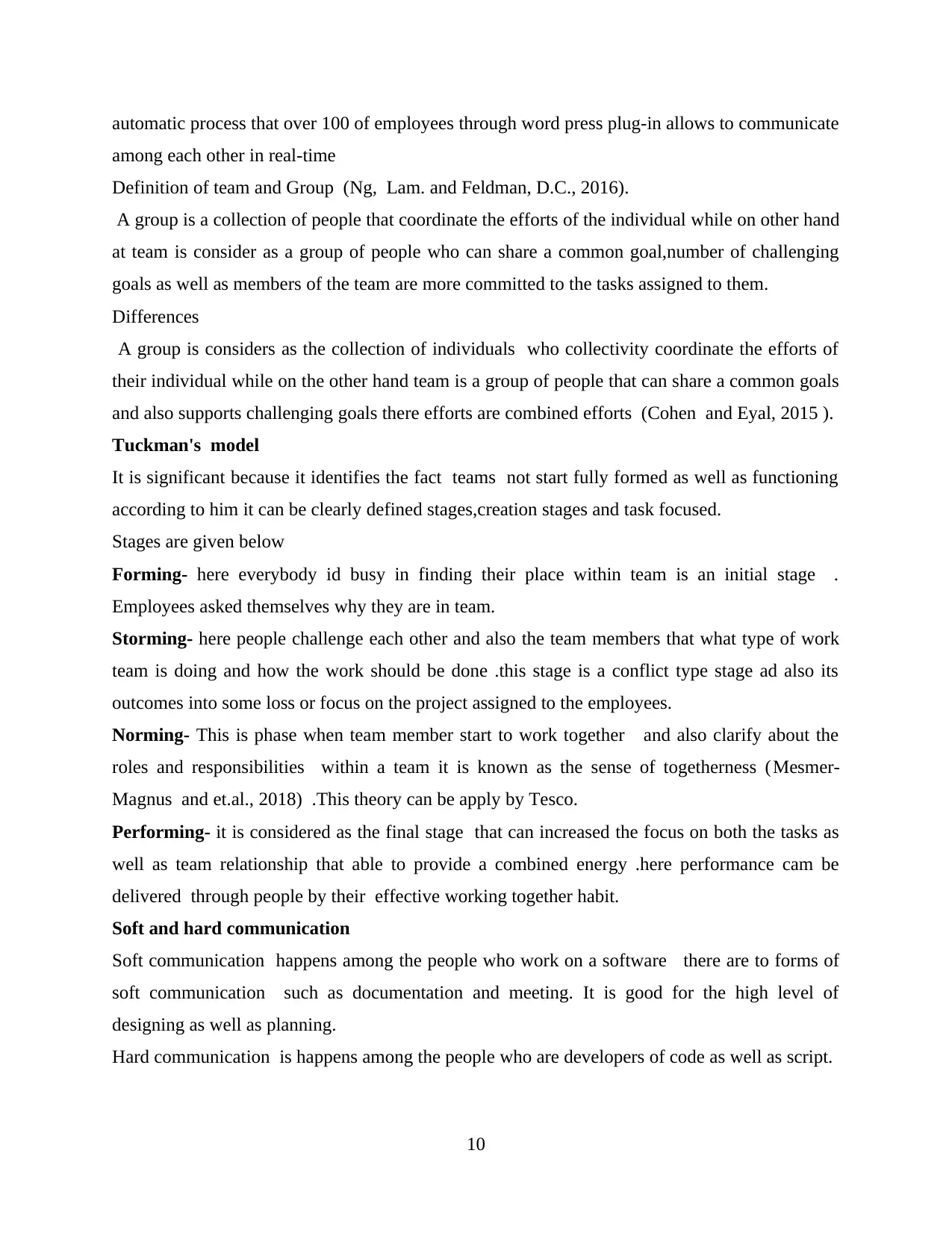
automatic process that over 100 of employees through word press plug-in allows to communicate
among each other in real-time
Definition of team and Group (Ng, Lam. and Feldman, D.C., 2016).
A group is a collection of people that coordinate the efforts of the individual while on other hand
at team is consider as a group of people who can share a common goal,number of challenging
goals as well as members of the team are more committed to the tasks assigned to them.
Differences
A group is considers as the collection of individuals who collectivity coordinate the efforts of
their individual while on the other hand team is a group of people that can share a common goals
and also supports challenging goals there efforts are combined efforts (Cohen and Eyal, 2015 ).
Tuckman's model
It is significant because it identifies the fact teams not start fully formed as well as functioning
according to him it can be clearly defined stages,creation stages and task focused.
Stages are given below
Forming- here everybody id busy in finding their place within team is an initial stage .
Employees asked themselves why they are in team.
Storming- here people challenge each other and also the team members that what type of work
team is doing and how the work should be done .this stage is a conflict type stage ad also its
outcomes into some loss or focus on the project assigned to the employees.
Norming- This is phase when team member start to work together and also clarify about the
roles and responsibilities within a team it is known as the sense of togetherness (Mesmer-
Magnus and et.al., 2018) .This theory can be apply by Tesco.
Performing- it is considered as the final stage that can increased the focus on both the tasks as
well as team relationship that able to provide a combined energy .here performance cam be
delivered through people by their effective working together habit.
Soft and hard communication
Soft communication happens among the people who work on a software there are to forms of
soft communication such as documentation and meeting. It is good for the high level of
designing as well as planning.
Hard communication is happens among the people who are developers of code as well as script.
10
among each other in real-time
Definition of team and Group (Ng, Lam. and Feldman, D.C., 2016).
A group is a collection of people that coordinate the efforts of the individual while on other hand
at team is consider as a group of people who can share a common goal,number of challenging
goals as well as members of the team are more committed to the tasks assigned to them.
Differences
A group is considers as the collection of individuals who collectivity coordinate the efforts of
their individual while on the other hand team is a group of people that can share a common goals
and also supports challenging goals there efforts are combined efforts (Cohen and Eyal, 2015 ).
Tuckman's model
It is significant because it identifies the fact teams not start fully formed as well as functioning
according to him it can be clearly defined stages,creation stages and task focused.
Stages are given below
Forming- here everybody id busy in finding their place within team is an initial stage .
Employees asked themselves why they are in team.
Storming- here people challenge each other and also the team members that what type of work
team is doing and how the work should be done .this stage is a conflict type stage ad also its
outcomes into some loss or focus on the project assigned to the employees.
Norming- This is phase when team member start to work together and also clarify about the
roles and responsibilities within a team it is known as the sense of togetherness (Mesmer-
Magnus and et.al., 2018) .This theory can be apply by Tesco.
Performing- it is considered as the final stage that can increased the focus on both the tasks as
well as team relationship that able to provide a combined energy .here performance cam be
delivered through people by their effective working together habit.
Soft and hard communication
Soft communication happens among the people who work on a software there are to forms of
soft communication such as documentation and meeting. It is good for the high level of
designing as well as planning.
Hard communication is happens among the people who are developers of code as well as script.
10
Secure Best Marks with AI Grader
Need help grading? Try our AI Grader for instant feedback on your assignments.
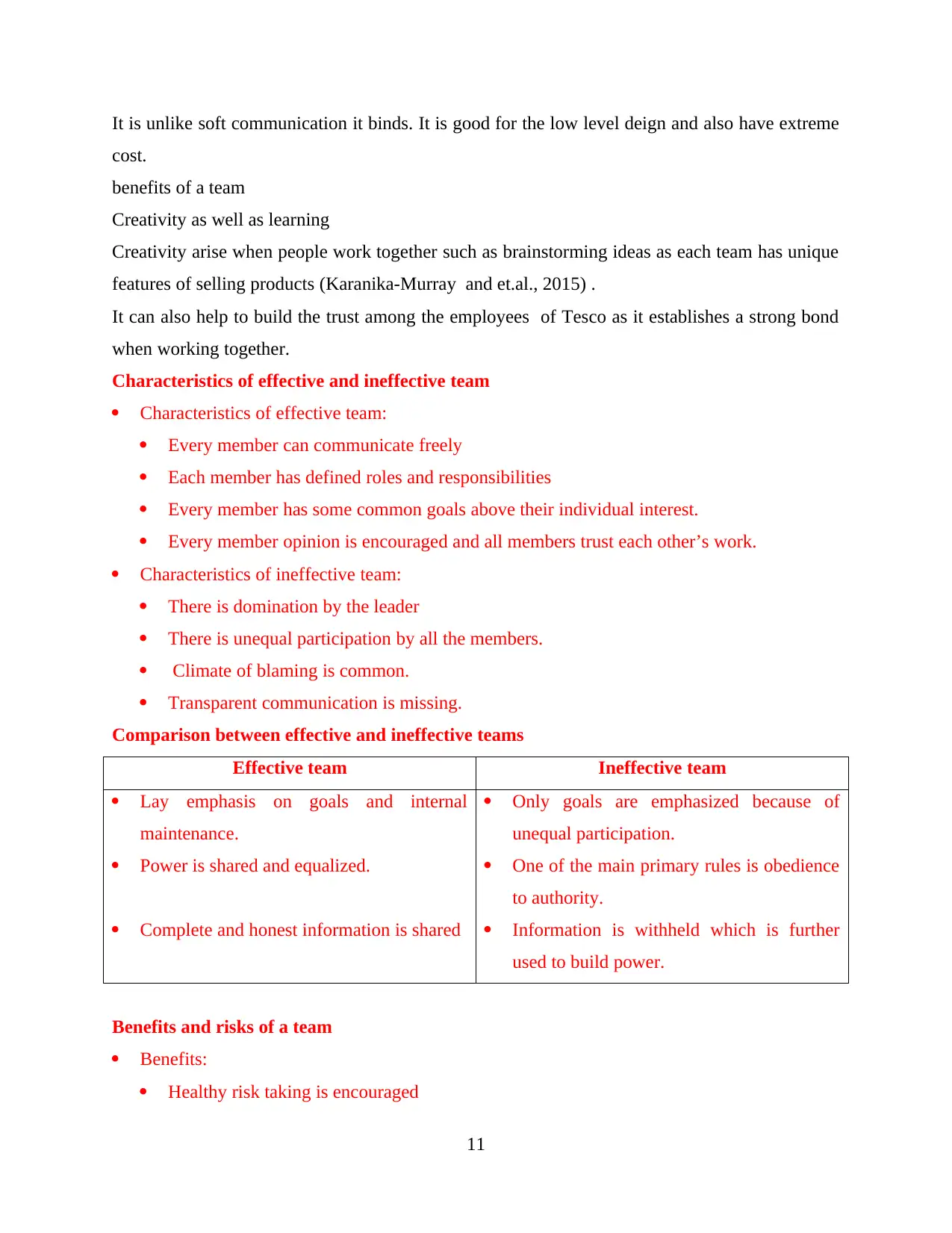
It is unlike soft communication it binds. It is good for the low level deign and also have extreme
cost.
benefits of a team
Creativity as well as learning
Creativity arise when people work together such as brainstorming ideas as each team has unique
features of selling products (Karanika-Murray and et.al., 2015) .
It can also help to build the trust among the employees of Tesco as it establishes a strong bond
when working together.
Characteristics of effective and ineffective team
Characteristics of effective team:
Every member can communicate freely
Each member has defined roles and responsibilities
Every member has some common goals above their individual interest.
Every member opinion is encouraged and all members trust each other’s work.
Characteristics of ineffective team:
There is domination by the leader
There is unequal participation by all the members.
Climate of blaming is common.
Transparent communication is missing.
Comparison between effective and ineffective teams
Effective team Ineffective team
Lay emphasis on goals and internal
maintenance.
Power is shared and equalized.
Complete and honest information is shared
Only goals are emphasized because of
unequal participation.
One of the main primary rules is obedience
to authority.
Information is withheld which is further
used to build power.
Benefits and risks of a team
Benefits:
Healthy risk taking is encouraged
11
cost.
benefits of a team
Creativity as well as learning
Creativity arise when people work together such as brainstorming ideas as each team has unique
features of selling products (Karanika-Murray and et.al., 2015) .
It can also help to build the trust among the employees of Tesco as it establishes a strong bond
when working together.
Characteristics of effective and ineffective team
Characteristics of effective team:
Every member can communicate freely
Each member has defined roles and responsibilities
Every member has some common goals above their individual interest.
Every member opinion is encouraged and all members trust each other’s work.
Characteristics of ineffective team:
There is domination by the leader
There is unequal participation by all the members.
Climate of blaming is common.
Transparent communication is missing.
Comparison between effective and ineffective teams
Effective team Ineffective team
Lay emphasis on goals and internal
maintenance.
Power is shared and equalized.
Complete and honest information is shared
Only goals are emphasized because of
unequal participation.
One of the main primary rules is obedience
to authority.
Information is withheld which is further
used to build power.
Benefits and risks of a team
Benefits:
Healthy risk taking is encouraged
11
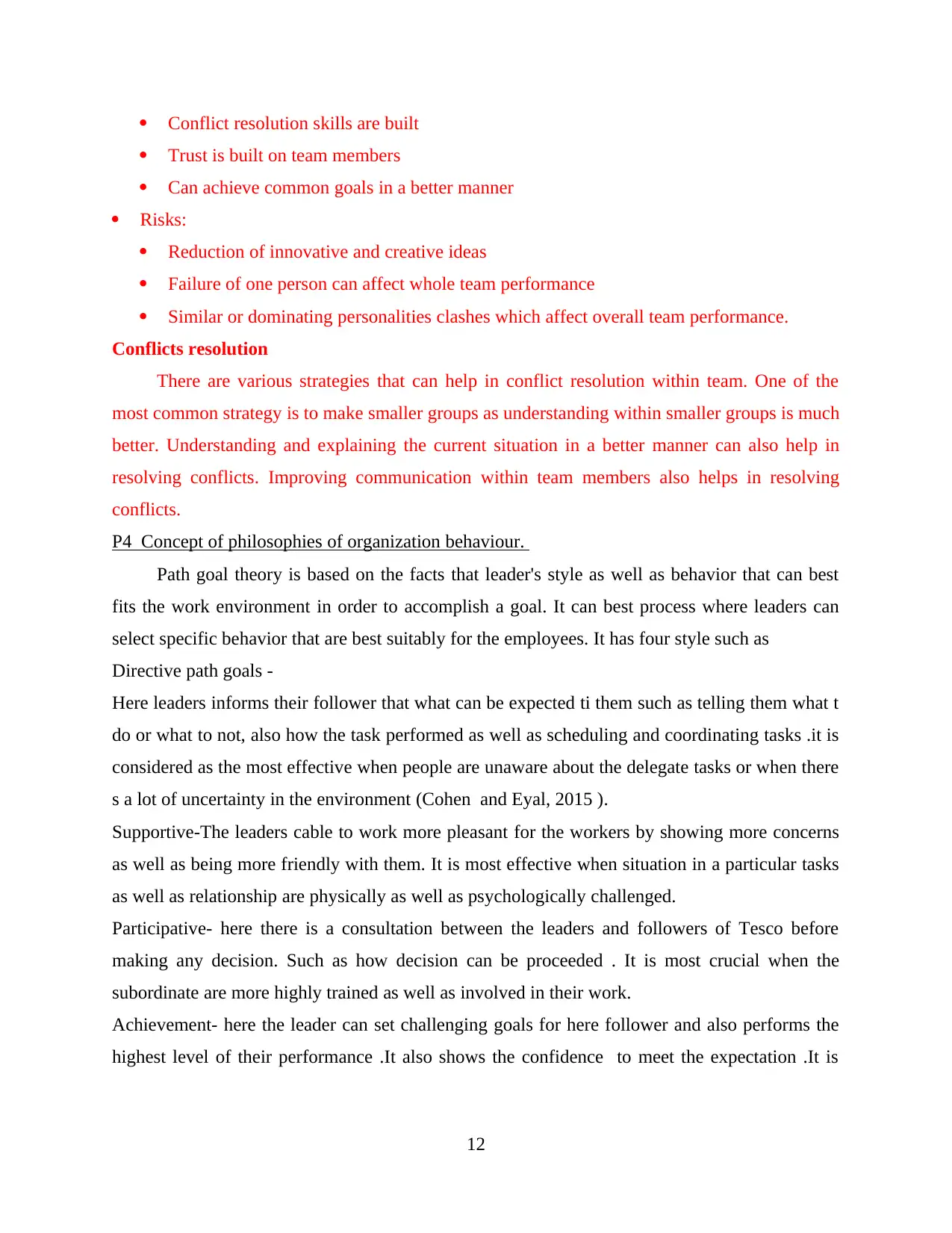
Conflict resolution skills are built
Trust is built on team members
Can achieve common goals in a better manner
Risks:
Reduction of innovative and creative ideas
Failure of one person can affect whole team performance
Similar or dominating personalities clashes which affect overall team performance.
Conflicts resolution
There are various strategies that can help in conflict resolution within team. One of the
most common strategy is to make smaller groups as understanding within smaller groups is much
better. Understanding and explaining the current situation in a better manner can also help in
resolving conflicts. Improving communication within team members also helps in resolving
conflicts.
P4 Concept of philosophies of organization behaviour.
Path goal theory is based on the facts that leader's style as well as behavior that can best
fits the work environment in order to accomplish a goal. It can best process where leaders can
select specific behavior that are best suitably for the employees. It has four style such as
Directive path goals -
Here leaders informs their follower that what can be expected ti them such as telling them what t
do or what to not, also how the task performed as well as scheduling and coordinating tasks .it is
considered as the most effective when people are unaware about the delegate tasks or when there
s a lot of uncertainty in the environment (Cohen and Eyal, 2015 ).
Supportive-The leaders cable to work more pleasant for the workers by showing more concerns
as well as being more friendly with them. It is most effective when situation in a particular tasks
as well as relationship are physically as well as psychologically challenged.
Participative- here there is a consultation between the leaders and followers of Tesco before
making any decision. Such as how decision can be proceeded . It is most crucial when the
subordinate are more highly trained as well as involved in their work.
Achievement- here the leader can set challenging goals for here follower and also performs the
highest level of their performance .It also shows the confidence to meet the expectation .It is
12
Trust is built on team members
Can achieve common goals in a better manner
Risks:
Reduction of innovative and creative ideas
Failure of one person can affect whole team performance
Similar or dominating personalities clashes which affect overall team performance.
Conflicts resolution
There are various strategies that can help in conflict resolution within team. One of the
most common strategy is to make smaller groups as understanding within smaller groups is much
better. Understanding and explaining the current situation in a better manner can also help in
resolving conflicts. Improving communication within team members also helps in resolving
conflicts.
P4 Concept of philosophies of organization behaviour.
Path goal theory is based on the facts that leader's style as well as behavior that can best
fits the work environment in order to accomplish a goal. It can best process where leaders can
select specific behavior that are best suitably for the employees. It has four style such as
Directive path goals -
Here leaders informs their follower that what can be expected ti them such as telling them what t
do or what to not, also how the task performed as well as scheduling and coordinating tasks .it is
considered as the most effective when people are unaware about the delegate tasks or when there
s a lot of uncertainty in the environment (Cohen and Eyal, 2015 ).
Supportive-The leaders cable to work more pleasant for the workers by showing more concerns
as well as being more friendly with them. It is most effective when situation in a particular tasks
as well as relationship are physically as well as psychologically challenged.
Participative- here there is a consultation between the leaders and followers of Tesco before
making any decision. Such as how decision can be proceeded . It is most crucial when the
subordinate are more highly trained as well as involved in their work.
Achievement- here the leader can set challenging goals for here follower and also performs the
highest level of their performance .It also shows the confidence to meet the expectation .It is
12
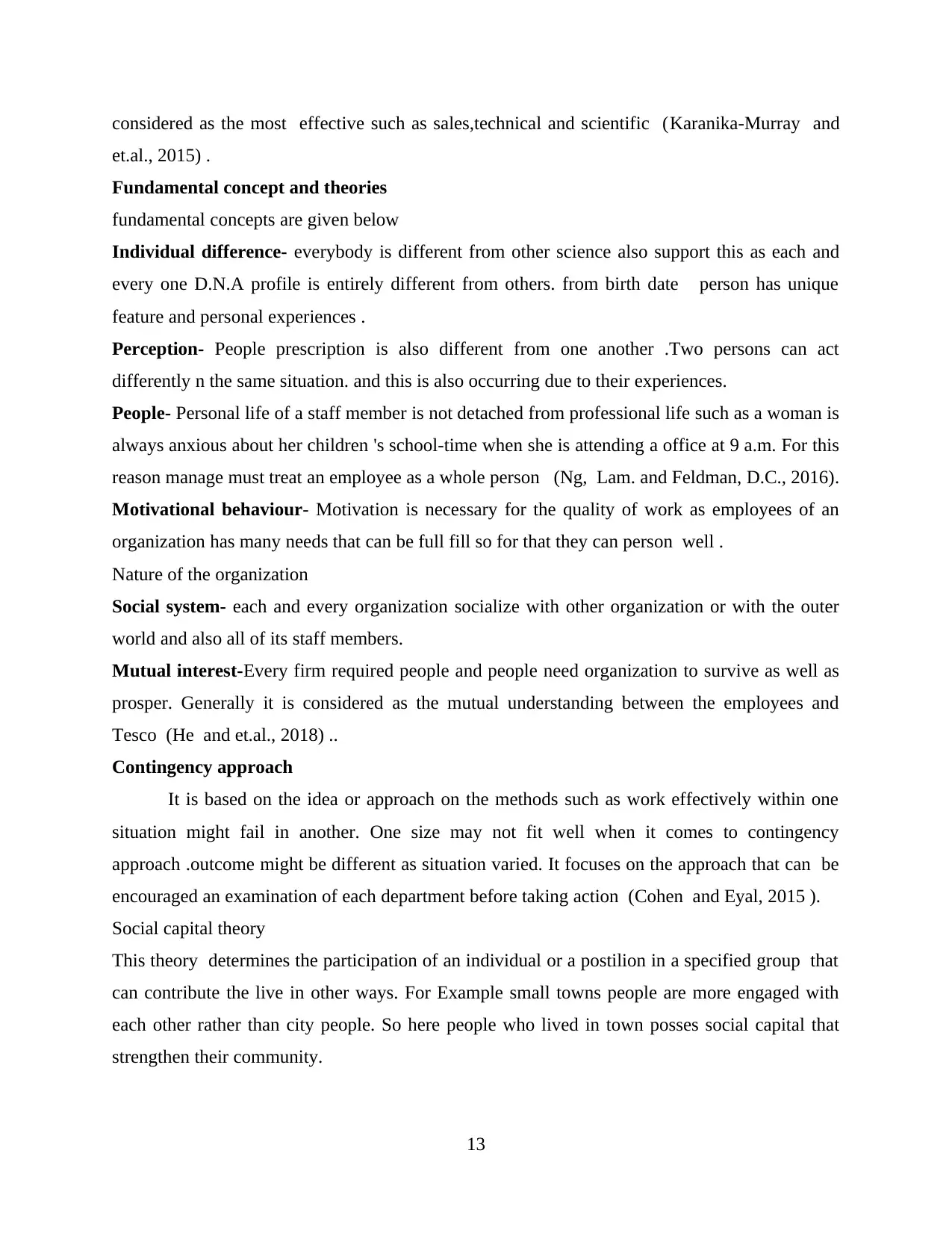
considered as the most effective such as sales,technical and scientific (Karanika-Murray and
et.al., 2015) .
Fundamental concept and theories
fundamental concepts are given below
Individual difference- everybody is different from other science also support this as each and
every one D.N.A profile is entirely different from others. from birth date person has unique
feature and personal experiences .
Perception- People prescription is also different from one another .Two persons can act
differently n the same situation. and this is also occurring due to their experiences.
People- Personal life of a staff member is not detached from professional life such as a woman is
always anxious about her children 's school-time when she is attending a office at 9 a.m. For this
reason manage must treat an employee as a whole person (Ng, Lam. and Feldman, D.C., 2016).
Motivational behaviour- Motivation is necessary for the quality of work as employees of an
organization has many needs that can be full fill so for that they can person well .
Nature of the organization
Social system- each and every organization socialize with other organization or with the outer
world and also all of its staff members.
Mutual interest-Every firm required people and people need organization to survive as well as
prosper. Generally it is considered as the mutual understanding between the employees and
Tesco (He and et.al., 2018) ..
Contingency approach
It is based on the idea or approach on the methods such as work effectively within one
situation might fail in another. One size may not fit well when it comes to contingency
approach .outcome might be different as situation varied. It focuses on the approach that can be
encouraged an examination of each department before taking action (Cohen and Eyal, 2015 ).
Social capital theory
This theory determines the participation of an individual or a postilion in a specified group that
can contribute the live in other ways. For Example small towns people are more engaged with
each other rather than city people. So here people who lived in town posses social capital that
strengthen their community.
13
et.al., 2015) .
Fundamental concept and theories
fundamental concepts are given below
Individual difference- everybody is different from other science also support this as each and
every one D.N.A profile is entirely different from others. from birth date person has unique
feature and personal experiences .
Perception- People prescription is also different from one another .Two persons can act
differently n the same situation. and this is also occurring due to their experiences.
People- Personal life of a staff member is not detached from professional life such as a woman is
always anxious about her children 's school-time when she is attending a office at 9 a.m. For this
reason manage must treat an employee as a whole person (Ng, Lam. and Feldman, D.C., 2016).
Motivational behaviour- Motivation is necessary for the quality of work as employees of an
organization has many needs that can be full fill so for that they can person well .
Nature of the organization
Social system- each and every organization socialize with other organization or with the outer
world and also all of its staff members.
Mutual interest-Every firm required people and people need organization to survive as well as
prosper. Generally it is considered as the mutual understanding between the employees and
Tesco (He and et.al., 2018) ..
Contingency approach
It is based on the idea or approach on the methods such as work effectively within one
situation might fail in another. One size may not fit well when it comes to contingency
approach .outcome might be different as situation varied. It focuses on the approach that can be
encouraged an examination of each department before taking action (Cohen and Eyal, 2015 ).
Social capital theory
This theory determines the participation of an individual or a postilion in a specified group that
can contribute the live in other ways. For Example small towns people are more engaged with
each other rather than city people. So here people who lived in town posses social capital that
strengthen their community.
13
Paraphrase This Document
Need a fresh take? Get an instant paraphrase of this document with our AI Paraphraser
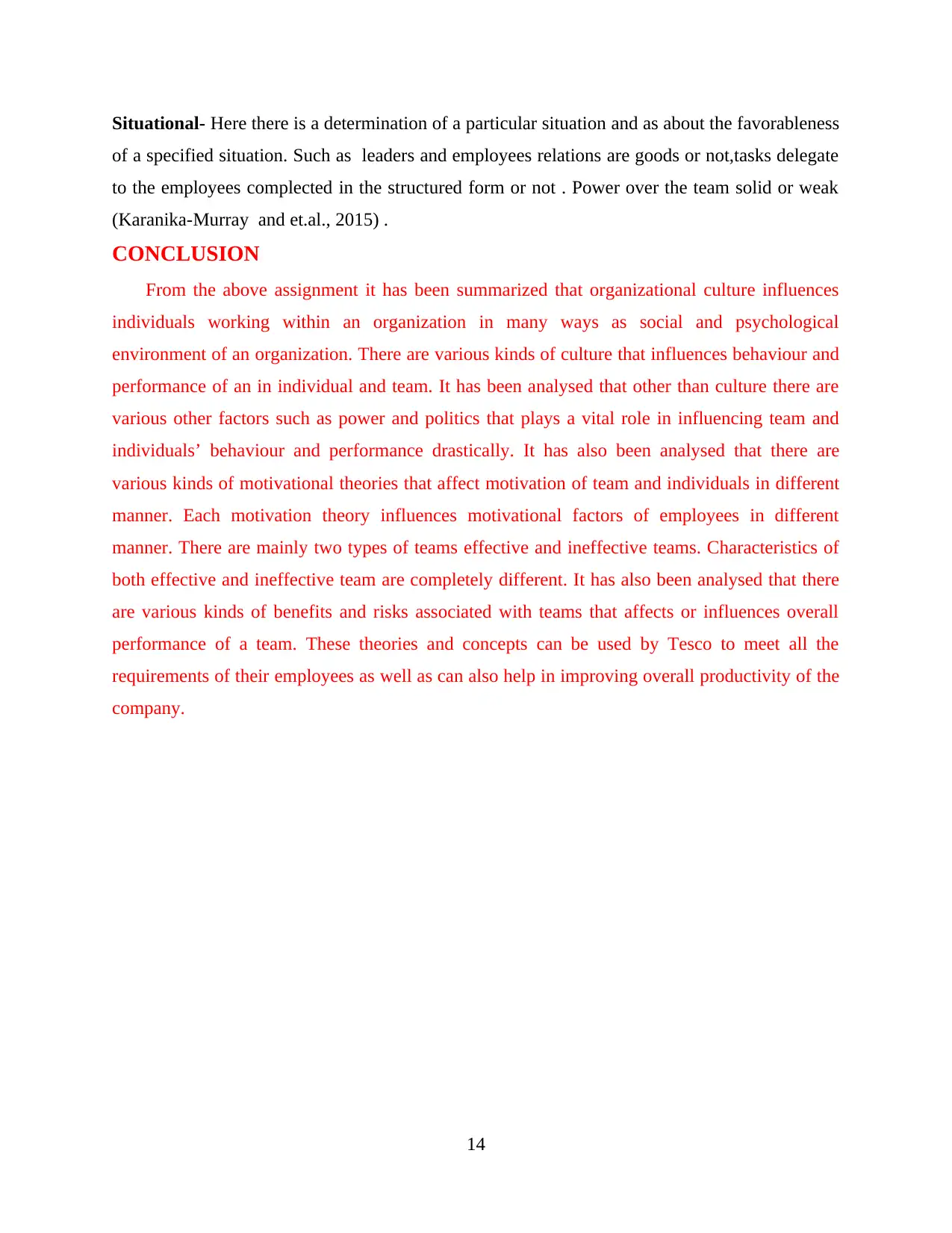
Situational- Here there is a determination of a particular situation and as about the favorableness
of a specified situation. Such as leaders and employees relations are goods or not,tasks delegate
to the employees complected in the structured form or not . Power over the team solid or weak
(Karanika-Murray and et.al., 2015) .
CONCLUSION
From the above assignment it has been summarized that organizational culture influences
individuals working within an organization in many ways as social and psychological
environment of an organization. There are various kinds of culture that influences behaviour and
performance of an in individual and team. It has been analysed that other than culture there are
various other factors such as power and politics that plays a vital role in influencing team and
individuals’ behaviour and performance drastically. It has also been analysed that there are
various kinds of motivational theories that affect motivation of team and individuals in different
manner. Each motivation theory influences motivational factors of employees in different
manner. There are mainly two types of teams effective and ineffective teams. Characteristics of
both effective and ineffective team are completely different. It has also been analysed that there
are various kinds of benefits and risks associated with teams that affects or influences overall
performance of a team. These theories and concepts can be used by Tesco to meet all the
requirements of their employees as well as can also help in improving overall productivity of the
company.
14
of a specified situation. Such as leaders and employees relations are goods or not,tasks delegate
to the employees complected in the structured form or not . Power over the team solid or weak
(Karanika-Murray and et.al., 2015) .
CONCLUSION
From the above assignment it has been summarized that organizational culture influences
individuals working within an organization in many ways as social and psychological
environment of an organization. There are various kinds of culture that influences behaviour and
performance of an in individual and team. It has been analysed that other than culture there are
various other factors such as power and politics that plays a vital role in influencing team and
individuals’ behaviour and performance drastically. It has also been analysed that there are
various kinds of motivational theories that affect motivation of team and individuals in different
manner. Each motivation theory influences motivational factors of employees in different
manner. There are mainly two types of teams effective and ineffective teams. Characteristics of
both effective and ineffective team are completely different. It has also been analysed that there
are various kinds of benefits and risks associated with teams that affects or influences overall
performance of a team. These theories and concepts can be used by Tesco to meet all the
requirements of their employees as well as can also help in improving overall productivity of the
company.
14
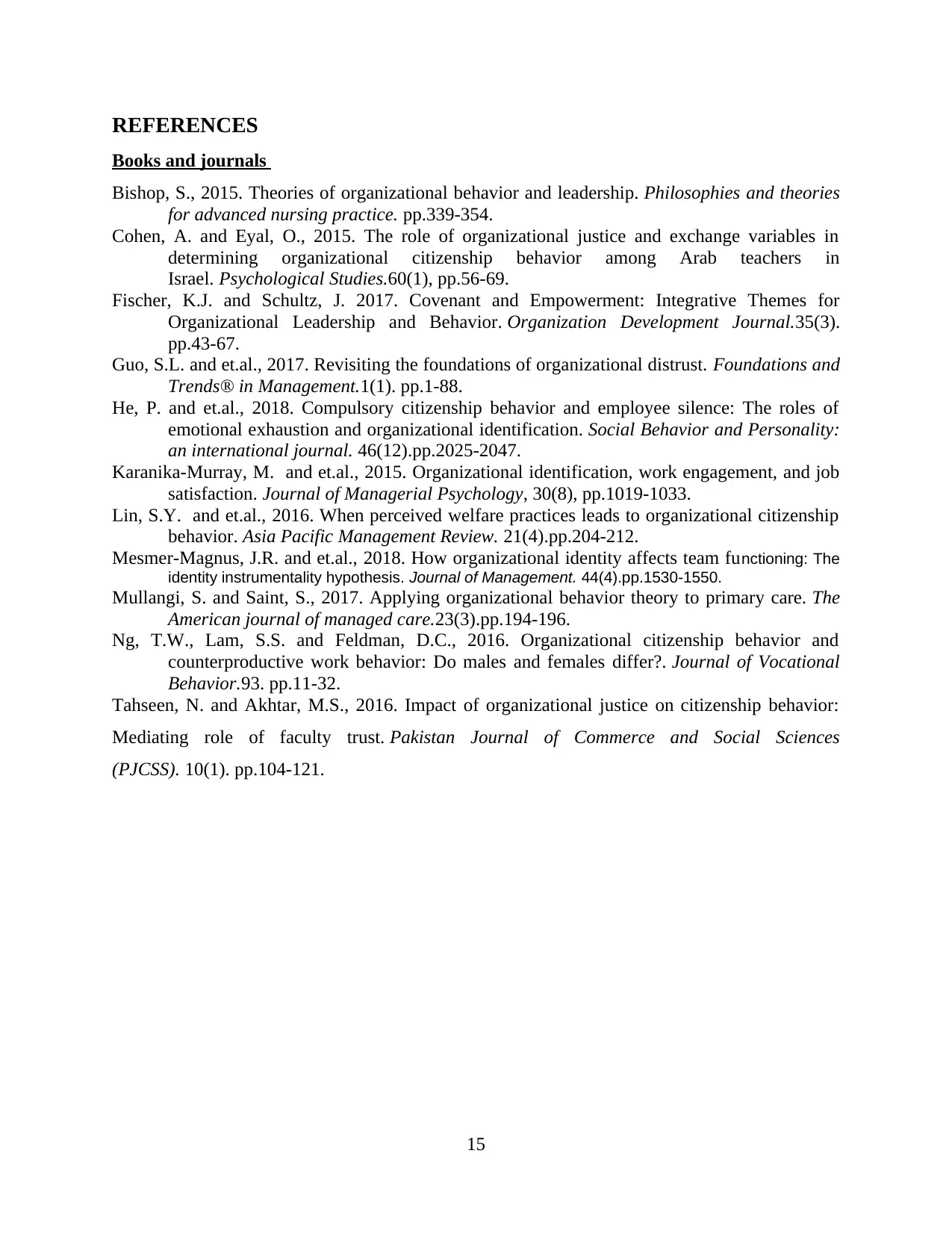
REFERENCES
Books and journals
Bishop, S., 2015. Theories of organizational behavior and leadership. Philosophies and theories
for advanced nursing practice. pp.339-354.
Cohen, A. and Eyal, O., 2015. The role of organizational justice and exchange variables in
determining organizational citizenship behavior among Arab teachers in
Israel. Psychological Studies.60(1), pp.56-69.
Fischer, K.J. and Schultz, J. 2017. Covenant and Empowerment: Integrative Themes for
Organizational Leadership and Behavior. Organization Development Journal.35(3).
pp.43-67.
Guo, S.L. and et.al., 2017. Revisiting the foundations of organizational distrust. Foundations and
Trends® in Management.1(1). pp.1-88.
He, P. and et.al., 2018. Compulsory citizenship behavior and employee silence: The roles of
emotional exhaustion and organizational identification. Social Behavior and Personality:
an international journal. 46(12).pp.2025-2047.
Karanika-Murray, M. and et.al., 2015. Organizational identification, work engagement, and job
satisfaction. Journal of Managerial Psychology, 30(8), pp.1019-1033.
Lin, S.Y. and et.al., 2016. When perceived welfare practices leads to organizational citizenship
behavior. Asia Pacific Management Review. 21(4).pp.204-212.
Mesmer-Magnus, J.R. and et.al., 2018. How organizational identity affects team functioning: The
identity instrumentality hypothesis. Journal of Management. 44(4).pp.1530-1550.
Mullangi, S. and Saint, S., 2017. Applying organizational behavior theory to primary care. The
American journal of managed care.23(3).pp.194-196.
Ng, T.W., Lam, S.S. and Feldman, D.C., 2016. Organizational citizenship behavior and
counterproductive work behavior: Do males and females differ?. Journal of Vocational
Behavior.93. pp.11-32.
Tahseen, N. and Akhtar, M.S., 2016. Impact of organizational justice on citizenship behavior:
Mediating role of faculty trust. Pakistan Journal of Commerce and Social Sciences
(PJCSS). 10(1). pp.104-121.
15
Books and journals
Bishop, S., 2015. Theories of organizational behavior and leadership. Philosophies and theories
for advanced nursing practice. pp.339-354.
Cohen, A. and Eyal, O., 2015. The role of organizational justice and exchange variables in
determining organizational citizenship behavior among Arab teachers in
Israel. Psychological Studies.60(1), pp.56-69.
Fischer, K.J. and Schultz, J. 2017. Covenant and Empowerment: Integrative Themes for
Organizational Leadership and Behavior. Organization Development Journal.35(3).
pp.43-67.
Guo, S.L. and et.al., 2017. Revisiting the foundations of organizational distrust. Foundations and
Trends® in Management.1(1). pp.1-88.
He, P. and et.al., 2018. Compulsory citizenship behavior and employee silence: The roles of
emotional exhaustion and organizational identification. Social Behavior and Personality:
an international journal. 46(12).pp.2025-2047.
Karanika-Murray, M. and et.al., 2015. Organizational identification, work engagement, and job
satisfaction. Journal of Managerial Psychology, 30(8), pp.1019-1033.
Lin, S.Y. and et.al., 2016. When perceived welfare practices leads to organizational citizenship
behavior. Asia Pacific Management Review. 21(4).pp.204-212.
Mesmer-Magnus, J.R. and et.al., 2018. How organizational identity affects team functioning: The
identity instrumentality hypothesis. Journal of Management. 44(4).pp.1530-1550.
Mullangi, S. and Saint, S., 2017. Applying organizational behavior theory to primary care. The
American journal of managed care.23(3).pp.194-196.
Ng, T.W., Lam, S.S. and Feldman, D.C., 2016. Organizational citizenship behavior and
counterproductive work behavior: Do males and females differ?. Journal of Vocational
Behavior.93. pp.11-32.
Tahseen, N. and Akhtar, M.S., 2016. Impact of organizational justice on citizenship behavior:
Mediating role of faculty trust. Pakistan Journal of Commerce and Social Sciences
(PJCSS). 10(1). pp.104-121.
15
1 out of 15
Related Documents
Your All-in-One AI-Powered Toolkit for Academic Success.
+13062052269
info@desklib.com
Available 24*7 on WhatsApp / Email
![[object Object]](/_next/static/media/star-bottom.7253800d.svg)
Unlock your academic potential
© 2024 | Zucol Services PVT LTD | All rights reserved.





